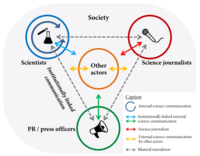
Photo from wikipedia
There is no doubt that innovations, particularly digital ones that provide online communication, are changing the way life is conducted across all levels of society and in all walks of… Click to show full abstract
There is no doubt that innovations, particularly digital ones that provide online communication, are changing the way life is conducted across all levels of society and in all walks of life (Barton & Lee, 2013). No single group is shielded from from the transformative, mediational and synergistic effects of digital media – the overarching theme of this issue of Communication. Research and Practice. The new levels of functionality that digital media afford to everyday communication routines, while sometimes destabilising, also provide significant benefits and new opportunities even to those who are not directly engaging with the media concerned. This age of ‘deep mediatisation’ (Couldry & Hepp, 2017, p. 34–56) allows non-users to benefit through the improved connectivity and access to digital information available to those digitally engaged people they deal with. For instance, with increased digitisation of textual records, images, and sound combined with the widespread use of digital devices by medical practitioners, doctors in many countries can digitally access a patient’s medical history at any time and from almost any location. A doctor treating a patient visiting their town from another region can gain access to the patient’s notes, prescribed medications, and clinical test results and view clinical images. This digital access supports efficient and informed decision-making and reduces the risk of misdiagnoses and prescribing new drugs that may have dangerous interactions with existing prescriptions. Such ‘vicarious benefits’ (for the non-user) are often overlooked in discussions about the benefits of new media and digitisation. Scholars seem predisposed to study those who actually use digital platforms rather than those who do not do so yet gain considerable benefit from the digital practices of others. For communication scholars, one of the benefits of the escalating digitisation and the steady stream of new digital communication technologies is that there is never a shortage of new topics to study. The range of digital media-related articles submitted to Communication Research and Practice is testimony to this expansion. What we see less often, however, are articles that take an ecological approach and reflect upon the situated and multidirectional influences of digitisation (Khan, Khan, & Aftab, 2015) and communication technology innovations and how these articulate with traditional media and non-mediated behaviour. One question that, in my view at least, warrants further study is the question of how new communication technologies recalibrate our thinking about communication, our perceptions of what constitutes effective communication and our expectations about how people will communicate with us and others to meet these expectations. We can see evidence of this recalibration in the way that each new communication platform or technology transforms in some way how communication scholars (and others too) talk about communication. COMMUNICATION RESEARCH AND PRACTICE 2020, VOL. 6, NO. 2, 71–78 https://doi.org/10.1080/22041451.2020.1750125
Journal Title: Communication Research and Practice
Year Published: 2020
Link to full text (if available)
Share on Social Media: Sign Up to like & get
recommendations!